Since March 1994 EXTREMUS Body Arts has been open in
Kansas City, Missouri. The following interview with Mick Noland,
co-owner and head piercer was conducted via email in September and
October of 1996. Photos supplied by EXTREMUS Body Arts. EXTREMUS is
located at 2020 Broadway, Kansas City, (816)756-1142. Mick can be
reached via email at [email protected]
or their web
page.
BME: How did you first become
interested in piercing?
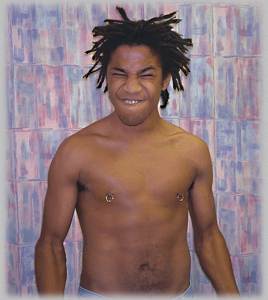 Mick: Like many body mod fans, I found National Geographic (magazines
and TV specials), showing body art practices around the world
fascinating. I read a great deal and became fairly conversant in
the subject... although there wasn't anyone to talk to about it!
And like a lot of pre-adolescents, I did the safety pin through
the tips of the fingers trick, sewed my fingers together to see
how they'd look if they were webbed, and so on. Always a great
gross-out on adults and girls. The opportunity never presented
itself to go further (at the time... we're talking the '60's
here) and it just became one more side interest. At this point I
was just a kid going to school, but at least I did learn I wasn't
afraid of needles or blood.
Mick: Like many body mod fans, I found National Geographic (magazines
and TV specials), showing body art practices around the world
fascinating. I read a great deal and became fairly conversant in
the subject... although there wasn't anyone to talk to about it!
And like a lot of pre-adolescents, I did the safety pin through
the tips of the fingers trick, sewed my fingers together to see
how they'd look if they were webbed, and so on. Always a great
gross-out on adults and girls. The opportunity never presented
itself to go further (at the time... we're talking the '60's
here) and it just became one more side interest. At this point I
was just a kid going to school, but at least I did learn I wasn't
afraid of needles or blood.
When and how did this
interest turn into a career?
Skipping ahead twenty-some years, my partner, Harold, selected
Jack Kaplan at Body Basics to do a tattoo on him and we made a
trip to Chicago.
Was being gay an important
part of piercing to you, or simply a peripheral fact of
life?
Nope, had absolutely nothing to do with it. I'm not much of a
participant in the generally recognized "gay life." (I don't go
to bars, don't cruise, don't party. Actually, I lead a very dull
life for someone in this biz. Must be those 72 hour weeks...)
I was reintroduced to body mod and Harold got a Prince Albert as
well as his tattoo. We decided we wanted more piercings, but
couldn't afford to run up to Chicago every time the mood struck
us, so I took some time off work and studied with Jack.
Was that a full-blown
apprenticeship, or learning while you were pierced?
It was a very intensive, short apprenticeship.
I wouldn't recommend it for most people, because there's just too
much to learn. But I wasn't a typical apprentice, being old
(over 35), a pre-med student in college (giving me a strong
background in microbiology, anatomy, and physiology), and having
many years of business experience behind me. A high IQ and
ability to absorb and retain information helped, too.
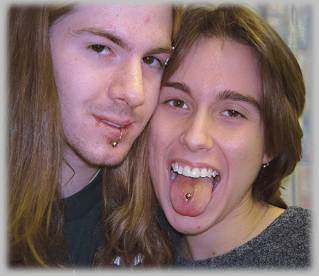 Most apprentices are young (18-24), have only a high school
education (which isn't nearly as good as the high school
education available 20 years ago), and little or no job
experience. Not only do they have to learn piercing, but the
basics of anatomy, of business -- maintaining inventory, budgeting,
etc., plus customer relations, and so on. My assumption is that
my apprentices will eventually have their own studios; if they
can't manage the studio, it won't matter how well they perform
piercings. This is a business, and to survive, they'll have to
be businessmen/women as well as piercers.
Most apprentices are young (18-24), have only a high school
education (which isn't nearly as good as the high school
education available 20 years ago), and little or no job
experience. Not only do they have to learn piercing, but the
basics of anatomy, of business -- maintaining inventory, budgeting,
etc., plus customer relations, and so on. My assumption is that
my apprentices will eventually have their own studios; if they
can't manage the studio, it won't matter how well they perform
piercings. This is a business, and to survive, they'll have to
be businessmen/women as well as piercers.
Being one of those type A++ personalities, I wasn't going to do
piercings unless I could do them right. Friends heard about my
new skill and I started doing piercings for them, and they sent
friends of friends....
So through careful practice
you became proficient?
I hope I'm continually improving. I'm always looking for a
better way to do my work. But even the first piercing I did on
Harold was "proficient." (Technically correct, well placed,
even, etc.)
I think that an artist of any kind continually improves through
practice, but there is a strong element of talent which matters,
too. There's an ability to make a piercing more comfortable and
enjoyable for the client which has nothing to do with the needle
or jewelry. As far as I can tell, it's something that can't be
taught. You have it or you don't. A beginner with this talent
(like Jerry Blain, my current apprentice) makes a client feel as
safe and comfortable when he's doing his first piercing, as when
he's doing his hundredth. In some ways it's like Karate -- being
able to visualize the perfect result and follow through to make
it real.
What I heard most was that people were very unhappy with the
piercing being done in Kansas City, that they didn't like the
look of tattoo studios in town, they had constant problems with
the piercings, and so on. Harold and I talked about it and
decided that the time was right for a piercing studio and that we
could afford to set one up the right way. For the first year, we
both continued to work our regular jobs, and split the studio
time, with Harold taking appointments and giving information
during the day, then I'd come in after work and do piercings in
the evening. By the end of the year I was able to quit my job
and work at the studio full time. Work and sleep pretty much
described that year.
How did your professional
career progress from there?
The studio's client base has continued to grow every year, thanks
to our very loyal clients and good word-of-mouth. We've been
featured on three of the four local television news programs (one
station twice) and had a CBS crew spend two days here doing a
feature for the CBS Evening News with Dan Rather. (To my
knowledge, it hasn't aired yet, though.) Our clients have
"spread the word" as far as Europe and Australia, and we're
listed in the resource sections of Skin Two and PFIQ.
We've had a feature article in In The Flesh (issue 2) and have
another coming up in Savage Tattoo.
Previous to opening your
studio you worked as a government employee -- Did piercing ever cause
any difficulties on the job for you?
As far as the government job, once you're a career employee (3
years), it's impossible to get fired for one's appearance. I was
already in an unique position (writing training material and
instructing management) with consistently excellent ratings, so I
didn't have to worry whether anyone liked my having piercings.
If anything, I made it easier for other employees to feel "safe"
getting visible piercings and tattoos since no one could complain
about line employees if a management person had them!
Do you think that piercing
is getting (socially) safer? Or is it only certain types of piercings
(navels, etc.) that are no longer marginalized?
It seems to depend entirely on where you live. On the West
Coast, pretty much any piercing is accepted, except perhaps in
the most conservative businesses. Here in Kansas City, it's
almost impossible to get a job if you have facial piercings,
outside of the arts, telephone sales, and a few private
businesses. Even minimum wage jobs (like MacDonalds) won't hire
people with visible piercings (and ear piercings are limited to
one for each ear). Many places won't let men have even ear
piercings, although that's being challenged more and more as sex
discrimination.
On the other hand, I do piercings on traditionally conservative
people like cops, doctors, and lawyers -- even facial piercings.
More people are willing to be the first to challenge the old
dress codes, because their piercings are that important to them.
It's a slow process, but all piercings are gaining more
acceptance. I see more parents coming in with their kids, then
deciding they (the parents) want to try it, too.
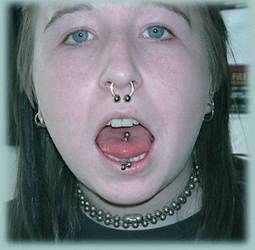 Do you think that one day
businessmen will be able to stretch their ears without social
concerns?
Do you think that one day
businessmen will be able to stretch their ears without social
concerns?
What I see is that one day business people simply won't care
about social concerns, because those concerns won't be a major
issue in their lives. These are appearance values of former
generations. Forty years ago, no man could get a job if his hair
grew over his ears. Now there are very few businesses which
would dare to require very short hair -- and for the most part,
they are businesses on the downside of the desirable-job slope.
How many kids want to grow up and become an IBM "suit"? Success
is what matters in the business world. The successful people
today don't look like the successful people in 1950. Twenty
years from now, personnel departments may expect to see baggy
jeans and t-shirts and piercings... and be hesitant to hire
someone in a three piece suit and a marine haircut as being "too
far out of the mainstream."
While we're looking into
the crystal ball, where do you see this whole piercing (and body
modification) thing going over the next couple of
years?
I anticipate a continuing, mild growth in the body arts over the
next few years. Five to ten years from now I expect a decline in
the body arts businesses overall. This will be the "shakeout"
period when the second-rate workers will drop out, since there
will no longer be the "quick buck" opportunities. There will
always be enough business for the quality studios and they'll
continue to prosper. Long-range, I expect there to be a higher
constant interest in body art than in the past, but more limited
to people with a strong interest, rather than just following the
latest Aerosmith video trend we're seeing now.
What a lot of people haven't realized is that there are more --
and younger -- people getting permanent body art -- tattoos,
large gauge piercings, scarification -- that will be with them
the rest of their lives. Often, these are in visible locations,
so they've already crossed the line of worrying about what
society thinks. These people will continue to be the core
clientele for many more years. They've already changed the
future, by not caring about how the past generations think of
them.
In your article in In
The Flesh, a very unique and controversial piercing is shown.
Could you tell us a little about that?
You're talking about "the Sprung", the mouth to chin piercing.
It is unique, and may well stay that way. Sara and I worked on
the placement and procedures for 8 months before I agreed to do
it. We consulted medical doctors about it, verifying that the
planned location wasn't in a danger zone, and were extremely
careful. Although the piercing itself was much easier than I
expected, the healing was difficult. Due to situations having
nothing to do with the piercing, she ended up taking it out after
about 8 months. We estimate it would have fully healed in about a
year.
I don't discuss the actual techniques, beyond the fact that it
can't be done with normally available equipment, because I don't
want someone else trying it without taking as long as we did to
make sure it's safe. I've had a number of requests for it, but
I'd only consider doing another Sprung on someone with extensive
experience with difficult piercings, and who lived nearby, so it
could be checked on at least weekly. The primary healing
problems were swelling of the underside of the chin (even after 8
months), and drooling through the piercing hole, especially
during sleep. It's one of those experiments which, however cool
it appears, isn't meant to be a commercial piercing.
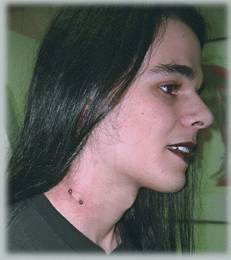 What do you think of the
recent fad (?) in piercing for surface piercings and unique and
technical piercings, such as the work of Jon Cobb, Steve Hayworth
(HTC), and Thomas Brazda (Stainless Studios)?
What do you think of the
recent fad (?) in piercing for surface piercings and unique and
technical piercings, such as the work of Jon Cobb, Steve Hayworth
(HTC), and Thomas Brazda (Stainless Studios)?
I have enormous respect for Jon Cobb. He approaches experimental
work much in the way I do -- research it to death, then try it
out on yourself or someone close and experienced in caring for
difficult piercings, and accept the fact they don't always work,
or shouldn't be commercially available. Just because something
can be done, doesn't mean it should be.
I set my limits at anything I can't be sure is safe and will be
successful (or, in the case of surface piercings, as successful
as surface piercings can be).
I do have concerns about people turning experimental piercings into
commercial piercings without going through the same ground-up research
as the originator. It's easy to assume that because one person can do an
experimental piercing safely, that everyone else can, too. But there's a
great deal that's "unspoken" between the initial idea and the resulting
piercing. What may seem workable initially may not work long-term. Anyone
interested in getting -- or doing -- a uvula piercing, for example, should
read Jon Cobb's comments in the rec.arts.bodyart FAQ. He no longer does
them specifically because of the long term problems. (Exactly the kinds of
problems I envisioned when I first heard about the uvula piercing -- and
why I haven't and won't do one.)
Creativity in the body arts is great, but safety is critical; not only for
the individual but for the industry. Many areas of the country are seeing
more regulation and legal problems because someone tried something beyond his
skills and knowledge. The state of Kansas recently passed regulations on
tattooing AND piercing as a direct result of complaints against one bad
tattooist.
Artists need to ask themselves: "Is what I plan to do safe? Is it legal?
What's the worst case scenario? Am I and my client prepared to deal with
the worst possibility?" Too often, artists assume the client knows the
ramifications of his request, when the client is just thinking "This looks
cool."
In many cases, there's a fine line between "body art" and practicing surgery
without a medical license. Body artists are not the ones who decide which
side of the line they're on -- courts do. Many artists think a waiver is
their safety net. But a waiver is meaningless in court. I've already seen
piercers lose lawsuits for botched piercings. It's just a matter of time
before someone gets hit with the practicing medicine without a license
charge -- and the artist will lose. I'm not willing to pay that price just
to call myself an innovator.
EXTREMUS is the only piercing-specialty studio in the region, and
one of the few studios who will pierce minors (with parental
permission), so we draw from a much larger area than Kansas City
alone. We've had people from as far away as North Dakota and
Texas come to Kansas City specifically for a piercing. I even
have clients who moved to Virginia and California, but comes back
at least once a year for a new piercing, saying they won't let
anyone else touch them! That's serious loyalty, and I'm very
proud and appreciative that my work is thought of so highly.
What are the legalities there
for piercing minors?
In Missouri, the minor has to have written consent from a
custodial parent or legal guardian. We check IDs carefully, and
have a separate form for parental/guardian consent. If the
parent or guardian doesn't sign it in front of us, the form has
to be notarized, with a copy of the parent/guardian ID attached.
For guardians, we have to see proof -- a court order or whatever.
Beyond that, my personal policy is that I'll only pierce minors
who are old enough to take care of their own piercings. That's
about 10 or 11, but I've turned away 17 year olds who acted less
mature than that (like throwing a temper tantrum in the studio to
convince mom to sign the waiver.)
At EXTREMUS, the piercer has the final say in whether someone
gets a piercing. If we think someone's been drinking or using
drugs (even if they say they haven't), we tell them to come back
another time. If someone seems unsure or it's obviously a matter
of peer pressure rather than a real interest, we talk them out
of the piercing.
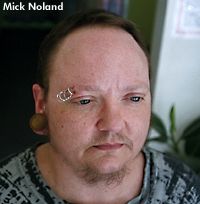


 Mick: Like many body mod fans, I found National Geographic (magazines
and TV specials), showing body art practices around the world
fascinating. I read a great deal and became fairly conversant in
the subject... although there wasn't anyone to talk to about it!
And like a lot of pre-adolescents, I did the safety pin through
the tips of the fingers trick, sewed my fingers together to see
how they'd look if they were webbed, and so on. Always a great
gross-out on adults and girls. The opportunity never presented
itself to go further (at the time... we're talking the '60's
here) and it just became one more side interest. At this point I
was just a kid going to school, but at least I did learn I wasn't
afraid of needles or blood.
Mick: Like many body mod fans, I found National Geographic (magazines
and TV specials), showing body art practices around the world
fascinating. I read a great deal and became fairly conversant in
the subject... although there wasn't anyone to talk to about it!
And like a lot of pre-adolescents, I did the safety pin through
the tips of the fingers trick, sewed my fingers together to see
how they'd look if they were webbed, and so on. Always a great
gross-out on adults and girls. The opportunity never presented
itself to go further (at the time... we're talking the '60's
here) and it just became one more side interest. At this point I
was just a kid going to school, but at least I did learn I wasn't
afraid of needles or blood. Most apprentices are young (18-24), have only a high school
education (which isn't nearly as good as the high school
education available 20 years ago), and little or no job
experience. Not only do they have to learn piercing, but the
basics of anatomy, of business -- maintaining inventory, budgeting,
etc., plus customer relations, and so on. My assumption is that
my apprentices will eventually have their own studios; if they
can't manage the studio, it won't matter how well they perform
piercings. This is a business, and to survive, they'll have to
be businessmen/women as well as piercers.
Most apprentices are young (18-24), have only a high school
education (which isn't nearly as good as the high school
education available 20 years ago), and little or no job
experience. Not only do they have to learn piercing, but the
basics of anatomy, of business -- maintaining inventory, budgeting,
etc., plus customer relations, and so on. My assumption is that
my apprentices will eventually have their own studios; if they
can't manage the studio, it won't matter how well they perform
piercings. This is a business, and to survive, they'll have to
be businessmen/women as well as piercers. Do you think that one day
businessmen will be able to stretch their ears without social
concerns?
Do you think that one day
businessmen will be able to stretch their ears without social
concerns? What do you think of the
recent fad (?) in piercing for surface piercings and unique and
technical piercings, such as the work of Jon Cobb, Steve Hayworth
(HTC), and Thomas Brazda (Stainless Studios)?
What do you think of the
recent fad (?) in piercing for surface piercings and unique and
technical piercings, such as the work of Jon Cobb, Steve Hayworth
(HTC), and Thomas Brazda (Stainless Studios)?